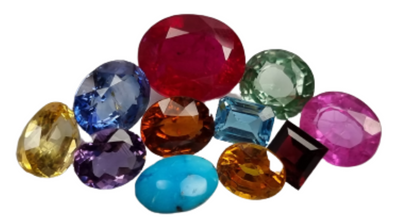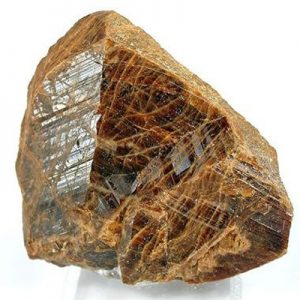Monazite: Gemstone Information
The latest authorities (Anthony et al., 2000) postulate three different species in place of the single undifferentiated monazite. The three minerals are monazite-(Ce), monazite-(La) and monazite-(Nd). All form crystals of the monoclinic system, the Ce and La form usually tabular and the Nd forms prismatic. Hardness is about 5.5 and SG 5.4; the Ce and La minerals may be radioactive from thorium content. Colors range from rose-red to a more common reddish brown.
Only monazite-(Ce) is transparent, the other two translucent; RI for the alpha, beta and gamma rays is 1.774–1.800, 1.777–1.801, 1.828–1.849, biaxial positive with birefringence 0.049–0.055. Very complex absorption spectra provide the best means of separating the three minerals from one another and spectral data handbooks need to be consulted. For convenience, a port manteau formula can be written as (Ce,La,Nd,Th)PO4. The minerals are found in igneous rocks including granite pegmatites.
Most examples reaching the gemmologist will have come from Madagascar or Sri Lanka, which produces orange pebbles. Color change (reddish orange in day light to pinkish brown in tungsten light) is reported but is common enough when RE are involved in the composition. Some specimens have shown a greenish fluorescence under LWUV.
Monazite: Unveiling the Splendor and Significance of a Gemstone Marvel
Monazite, a mesmerizing mineral with a rich history and remarkable properties, has captivated gemstone enthusiasts for centuries. Renowned for its radiant colors and diverse applications, monazite holds a special place in the world of gemstones. In this article, we delve into the origins, characteristics, and benefits of monazite, shedding light on its allure and significance.
Origins and Formation
Monazite derives its name from the Greek word “monazein,” meaning to be solitary, due to its relatively isolated occurrences in nature. It is a phosphate mineral that primarily forms in granitic and pegmatitic rocks, as well as in placer deposits derived from the erosion of these rocks. Monazite crystals may be found in a range of colors, including yellow, brown, red, and green, depending on its chemical composition and impurities.
Physical and Optical Properties
One of the distinguishing features of monazite is its vibrant coloration and crystal habit. It commonly occurs as prismatic crystals with a translucent to transparent appearance and a vitreous to resinous luster. Monazite crystals may also exhibit pleochroism, displaying different colors when viewed from different angles.
Monazite’s colors are highly variable and may include shades of yellow, brown, red, green, and sometimes black. This diversity of colors makes monazite a sought-after mineral for collectors and lapidaries alike, as it lends itself well to various forms of jewelry and ornamental objects.
Metaphysical and Healing Properties
In addition to its visual appeal, monazite is revered for its metaphysical and healing properties, believed to resonate with energies of vitality, transformation, and spiritual growth. It is often associated with the solar plexus and root chakras, facilitating a sense of grounding, strength, and stability.
Monazite is said to stimulate the mind, enhance mental clarity, and promote a positive outlook on life. It is believed to inspire courage, determination, and perseverance, helping individuals overcome obstacles and achieve their goals with confidence and resilience.
In the realm of emotional healing, monazite is thought to dispel feelings of fear, doubt, and negativity, encouraging individuals to embrace change and embrace new opportunities for growth and self-discovery. It is said to promote a sense of inner peace, balance, and harmony, fostering emotional well-being and resilience.
Uses and Applications
Monazite’s vibrant colors and unique properties make it a versatile mineral with a wide range of uses and applications. In the realm of jewelry, monazite is often faceted or polished into gemstones, cabochons, and beads, showcasing its natural beauty and brilliance. It may also be used in ornamental objects, decorative carvings, and collector’s specimens, adding a touch of elegance and sophistication to any collection.
In metaphysical practices, monazite is used as a meditation aid, facilitating deep states of relaxation, introspection, and spiritual connection. It is believed to enhance intuition, psychic abilities, and spiritual insights, guiding individuals on a journey of self-discovery and inner exploration.
Care and Maintenance
To preserve its beauty and integrity, monazite jewelry should be handled with care and cleaned gently using a soft, damp cloth. Avoid exposing monazite to harsh chemicals or abrasive cleaners, as these may damage its delicate surface and affect its luster. Store monazite jewelry separately from other gemstones to prevent scratching or abrasion, and avoid exposing it to prolonged sunlight or heat, as this may cause fading or discoloration over time.
Conclusion
Monazite stands as a gemstone of timeless beauty and profound significance, captivating hearts and minds with its vibrant colors and metaphysical properties. From its origins in granitic and pegmatitic rocks to its diverse applications in jewelry and metaphysical practices, monazite continues to inspire and enchant individuals around the world.
Whether used as a decorative accent, meditation aid, or tool for emotional healing, monazite serves as a reminder of the inherent beauty and wisdom present in the natural world. With its soothing energies and vibrant colors, monazite invites us to explore the depths of our innermost selves, guiding us on a journey of self-discovery and spiritual growth.





